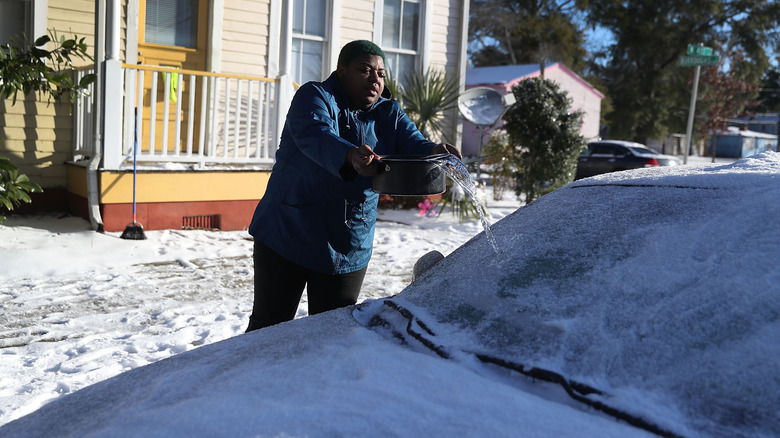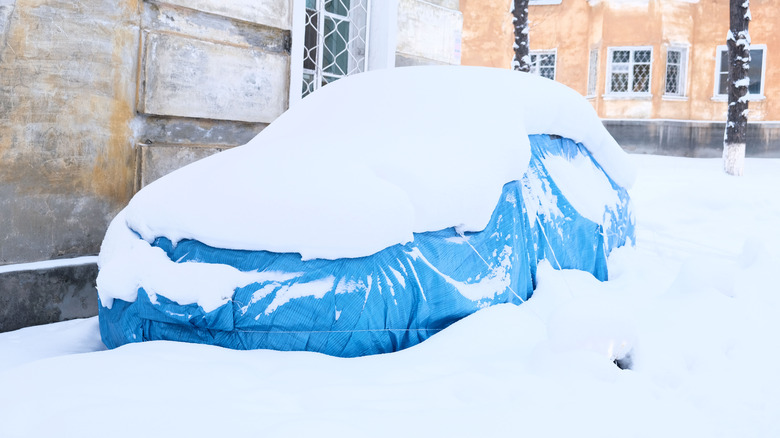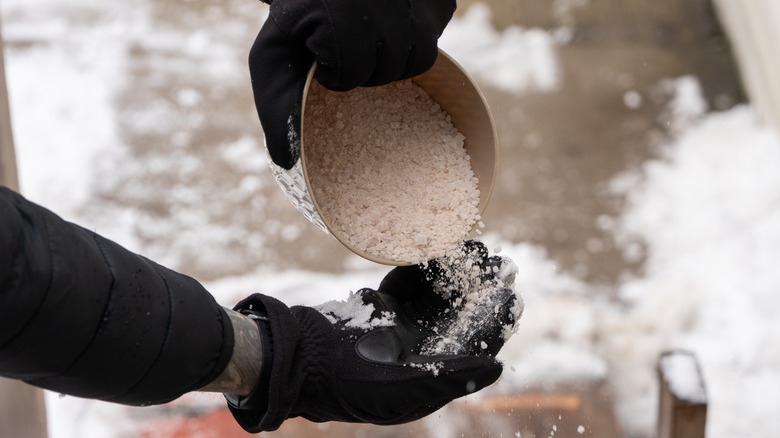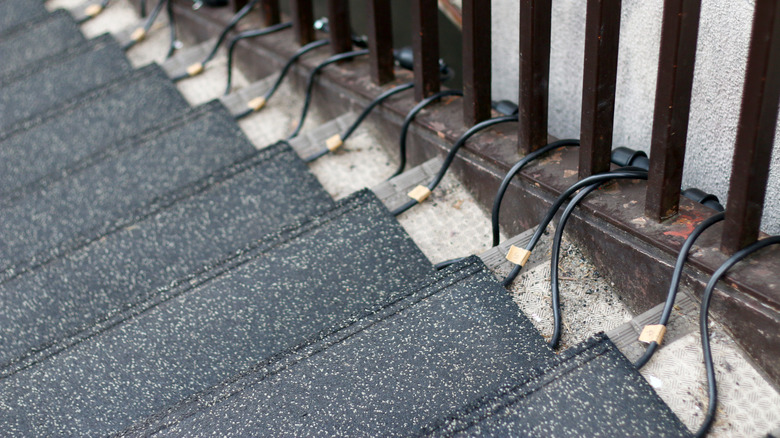Clever Hacks That Make Snow Removal Easier Than Ever
"Snow. Snow. Snow. Snow. Snooooooow. It won't be long before we'll all be there with snow." While the "White Christmas" reference makes snow seem like some benevolent force that exists purely to make the winter holidays festive and scenic, there is another side to the fluffy white stuff that has plenty of people downright livid to see its appearance in the sky. When snow comes down in droves, it can be one of the biggest pains for anyone living in areas that see it frequently. And though it eventually ends up becoming another part of living life, figuring out easier ways to remove it from your trafficked walkways can help make the snowy season all the more tolerable.
Removing snow doesn't have to be one of the most aggravating and time-consuming of outdoor tasks. On the contrary, it can actually become rather quick and easy if you are properly prepared, and have a plan of attack. Having the right tools for the job, as well as developing a mindset to work through a snowstorm, are great hacks that can make cleaning up after any blizzard a breeze.
From choosing the right shovel, to making your own homemade ice melt, here are 13 clever hacks that make snow removal easier than ever.
Use the right shovel
First things first, you need the right shovel. This is perhaps the most straightforward hack of them all. While it might not seem like that big of a deal, having the right shovel, or shovels, for the job is going to make your time removing snow a heck of a lot easier. And though an amount of personal preference is involved, there are some standards you need to go by in order to make that snow removal a breeze.
A shovel with the right ergonomics is key for success in snow removal. This depends on your height and shoveling style, first and foremost. You don't want a shovel that is too short and therefore does not provide you with the right angle for which to push snow without strain on your back. There are shovels specifically designed to be ergonomically friendly. However, these tend to make it somewhat difficult to lift heavy snow and are best used for pushing lighter loads.
The other key is to have a sharp blade for cutting underneath any ice build up and larger piles of snow. And finally, you want to look for shovels that are well constructed. Snow can be heavy, and many plastic handles on shovels are not built well enough to handle repeated moving of hard snow. A solid, wooden body and handle are going to be your best bet for shoveling success.
Use cooking spray on your shovel
There are two types of snow: light and fluffy, or wet and heavy. The first type is so easy to move you wonder why shoveling is such a pain to begin with. Then you get the second stuff and remember. When snow is loaded with additional moisture, not only does it become heavy, it becomes sticky too. This is especially true if you have a metal shovel, because the temperature difference between the metal and snow makes for an extra grippy surface. Fortunately, there is an easy way to fix this.
Almost everyone has some kind of cooking spray or oil in their kitchen. Simply take the spray or the oil and give your shovel a good once over, making sure to get the back of the shovel as well as the inner bowl. After you've done this, the snow simply will not stick to your shovel any longer. The surface tension between the oil and the moisture in the snow will prevent any of the snow from sticking to the metal of the shovel.
This is a time honored hack that has been practiced for generations. It is exceedingly practical and easy to achieve using just what you have laying about the house. Plus, it saves you some time and aggravation from constantly needing to remove wet, heavy, and sticky snow from your shovel.
Create a shoveling schedule
Here's a big mistake many people make regarding snow removal. To make things easier, they think they will wait out the storm and shovel once it stops. There is a big problem with this. Waiting until the snow has finished falling means you will have to remove several inches or feet of snow in one sitting. Not only is that a lot of heavy, sometimes back-breaking work, but it's also going to take you a lot longer than it would if you had made a shoveling schedule to begin with.
Creating a shoveling schedule is an easy way to manage the snow build-up during an extended storm. It doesn't take all that long for several inches worth of snow to pile up. So, even though it means you'll have to go out more times, you're actually keeping the snow at bay and saving a lot of time and energy by working with lighter snow loads.
Create a schedule that gets you outside about every hour or two. These time frames obviously depend on how fast the snow is falling, so adjust your timing to the snowfall. Doing this will keep the snow from packing up and becoming too heavy or immovable. Plus, the less you have to shovel in the morning, the less you'll end up being stressed before your commute.
Use sand on slippery areas
If you've ever been behind a snow plow and seen the sand flying out of the auger attached to the back of the truck, you need that stuff at your house. The sand is for additional traction on slippery areas. It creates a layer between the snow and the wheels of the car, providing added traction as the driver meanders along the snow covered roads. The same principle can be applied to the slippery areas at your home.
Many local highway departments will have sand available for residents to take home and use. Hardware stores should also have 60 pound bags of the stuff on sale, but if you can get it for free from the DPW, then go with that route. Using a shovel or a broadcast fertilizer spreader, spread the sand over icy or slippery areas of your property. The added layer will help give your boots traction, much like with the wheels on the road.
Sand is also particularly helping in removing the slip from compacted areas. Sometimes the snow can get too compacted to be removed by a shovel or snow blower. Ice can easily build up in these areas, making them difficult to traverse. Spreading sand along these paths is an easy way to make travel easier as you wait for the weather to warm and the snow to loosen.
Lukewarm water for the car or walkway
This hack should be used with some amount of caution. It may seem counterintuitive to be adding more water to areas that are already packed with frozen moisture. However, in certain situations, the addition of lukewarm water can actually aid in the removal of snow and ice from certain areas.
To be clear, you should never spread water along your driveway or front steps unless you are using it to dislodge some particularly stuck snow and immediately remove it from the area. Otherwise, there is no better way to get ice build up than by pouring hot water on your steps. The temperature of the water is actually quite important. Hot water can actually freeze faster than warm or cold water. So, by keeping the water lukewarm, you allow it to melt what needs melting, without it immediately freezing back up on you.
Using lukewarm water works best on removing ice from your car locks and windows. You may have to do this several times, but several successive applications of lukewarm water will gently remove the snow and ice from your car. You can then easily scrape it off and remove the snow and water from your car and driveway before ice has the chance to build up.
Use tarps
Tarps are one of the greatest of all snow removal tools. While you're not likely to cover your entire driveway with a tarp, covering certain areas, like your car, front steps, walkway, and firewood pile is going to make snow removal far easier. This is especially true when it comes to cars.
Scraping snow off of your car is tedious and can very easily become frustrating. Getting the windshield is particularly tricky. So, by covering your car, all you need to do is pull away the snow covered tarp, do a little shoveling to get it out from around the vehicle, and be on your merry way. The same principle applies to your front steps and your walkway.
Now, this is really best for snow flurries or storms that only yield a few inches. This method is really not suited for blizzards, as just one cubic foot of snow can easily weigh up to 20 pounds. While you can still use the tarp to protect your car, it's not going to be nearly as easy to remove the heavy, post blizzards snow, as it is going to be a few inches of the light stuff. So, this works, but only in certain situations.
Use a leaf blower for light snow
This method is a lot of fun. For anyone who hates shoveling, and we mean really hates shoveling, your leaf blower is going to be a tremendous option for removing snow from your property. This hack is so clever and so easy, you won't actually feel like you are doing any work. Subbing in your shovel for a leaf blower is going to make removing the snow from your yard easy and a heck of a lot of fun.
Whether your leaf blower is gas or electrically powered, the effect is the same. Like leaves, pointing the leaf blower at your snow is going to send it off in the direction you want with the help of some well circulated wind. This'll cut your snow removal time in half.
The one downside to this method is that it really only works with the lighter snows. While the leaf blower can toss several inches worth of powder into piles along the side of the driveway, it doesn't work so well with the heavy or frozen over stuff. For that, sadly, you'll still need a shovel or snow blower.
Wear socks over your boots
Wear socks over boots? Yes, really. You're probably thinking, "I spent good money on my boots. They're supposed to have additional traction on the ice and snow, and keep my feet extra warm!" That may be, but socks are actually your ticket to extra grip and stability while you're out working in the snow.
Obviously, you're not going to wear boots without your socks. Therefore, it would behoove you to have an extra pair on hand to put on over your boots. This is going to make your time outside a lot easier. It's been noted on certain occasions that socks, for whatever reason, seem to provide your boots with an added layer of traction on the slippery, snow covered surfaces.
So, if you don't mind looking a touch silly, take some long, wooly socks and put them on over your boots. See if the trick actually works for you. It seems to have for several people during their slippery morning commutes over the years.
Invest in a roof rake
Here's an unfortunate fact: not all houses are built to take snow loads. One of the reasons you see such steep pitches on early, colonial New England homes is because they were specifically designed to shed snow. This is also why you see a lot of A-frame cabins in Europe and the ski resorts of the Rockies. Flat roofs are not efficient at removing snow. They therefore need to be shoveled, or raked in order to remove the snow and prevent the roof from collapsing in on the inhabitants.
A roof rake is an excellent investment for protecting any home, pitched or otherwise, from snow damage. They stretch well in excess of 20 feet and can very easily reach up to the edges of roofs. They will catch the snow as you pull down on the rake and send the snow to the ground in piles where it can easily be shoveled away.
Though most roofs are designed to remove snow, having a rake offers great peace of mind. Apart from removing heavy snow, roof rakes can also easily remove ice dams from the sides of houses.
Make homemade ice melt
Let's face it, the bags of ice melt, sand, and rock salt you buy from the hardware store can get expensive, especially if you have to buy multiple bags in a season. This is why you need to use these recipes for homemade ice melts that you can use on your car or your driveway. First is a simple liquid melt. The recipe is a simple combination of water, soap, and rubbing alcohol. Mix this all together and use it to remove ice and packed snow from the handles, locks, windows, and windshields of your car, or to loosen up that stubborn bit of ice on your front stoop.
Though the words don't sound particularly friendly, magnesium chloride is actually an affordable, and safe, way to remove ice from your driveway. It costs less than rock salt, is safe for pets to walk on, and won't ruin your plants. It will help remove all of the ice and snow build up from your driveway without you needing to spend a ton of money on alternatives.
Invest in heated mats
This is certainly more of an upgraded luxury tarp, but it is certainly worth the several hundred dollars of investment, especially if you have a business. The very last thing you need is people slipping. An electrically-heated mat easily removes snow from porches, car windshields, walkways, store entrances, and front steps. The construction of the mats allows for them to be placed outside, snowed upon, and then heated up to melt away the snow and prevent ice from forming.
They come in several different lengths and widths, and with different powering options. You can either plug them into a wall outlet and use an extension cord to get them outside where you need to go, or you can get ones that are battery powered. The latter might be a better option, especially if you are using the heated pad to remove snow from the windshield of your car.
These heated pads will only do part of the work, which is an unfortunate downside to them. They will clear a path just wide enough for you to get through, but not much else. Still, they can be excellent for getting those hard to reach places that a snow blower or shovel might not be the best tools to use.
WD-40 is your best friend
A truer statement has never been spoken. For anyone who owns a home, likes to tinker, or has snow to remove from their driveway, WD-40 is going to be your friend. You should have a can of this available at all times because it can be used for so many different projects. When it comes to snow, however, WD-40 really comes into its own.
Made using a special blend of petroleum oil and hydrocarbon lubricants, WD-40 is designed to displace water, hence the WD in the title. As snow is 100% water, WD-40 will work well at removing it. The lubricant will release your frozen car lock, clear frozen pipes or taps, and even keep ice and snow from sticking to your shovel. It really comes in handy, however, if you have a snow blower.
Apart from loosening screws and cleaning built up oil and grime, WD-40 can also be a great help in keeping snow from building up inside the auger and chute of a snow blower. As WD-40 doesn't freeze, it will help keep the auger and chute lubricated enough to keep snow and ice from clogging things up.
Invest in a snowblower or plow
A lot of the hacks on this list have been about saving money, time, and aggravation. However, this last tip is one that you need to consider if you live in places that consistently see several feet of snow in a given year. Investing in a snow blower or a plow for your truck are both enormous investments, worth several thousands of dollars. However, if you have a driveway that is incredibly long, see several feet of snow in a single storm, or live on a private road, those investments are going to pay for themselves in a jiffy.
A snowblower is going to be less money than a plow, and is probably the option that the majority of people are going to go for in the long run. Truck plows should really only be purchased if your property requires it, and if you have the opportunity to work with the municipality to plow town roads. If you have a rider mower, tractor, or gator, you can also get snow blowers and plow attachments for these to make the work much easier.
So, while snow removal is not what anyone would consider to be "fun," at least now you have some hacks at your disposal to make it all the easier this winter. Whether you invest in that plow or just rub olive oil on your shovel, you should be in for a much smoother snow season with these hacks.













